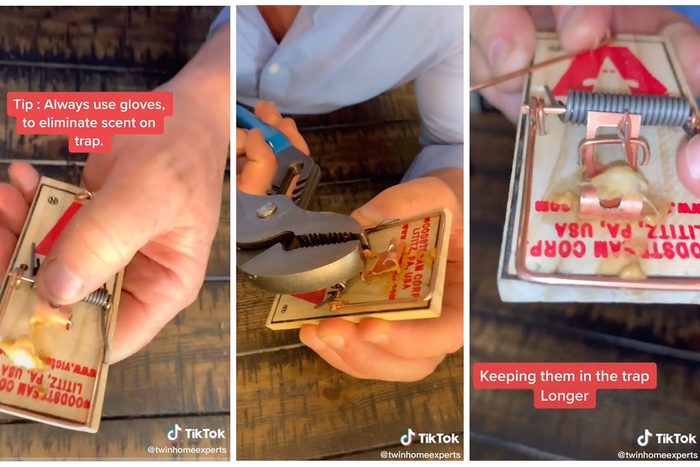If Your Mice Traps Aren’t Working, These Hacks Will Help

Are your mousetraps not working? Here are some easy solutions to solve your latest pest problem for good.
If you’re dealing with a pest problem—namely, a mouse or two—the common solution is to set up some traditional mousetraps around your home. However, you might be surprised when you notice mousetraps not working. Sometimes, a mouse might be able to get the bait without activating the trap. Other times, the mechanism isn’t sensitive enough to react because the mouse acts too quickly.
To stop playing cat and mouse (pun intended), learn these easy hacks to make your mousetraps more successful.
What to Do When Your Mousetrap Isn’t Working
TikTok regulars @twinhomeexperts posted some helpful hacks to try whenever you find mousetraps not working. The solutions don’t require extra purchases and don’t take long. All you’ll need are traditional mousetraps and some everyday household items.
@twinhomeexperts When MICE traps don’t work, try these 3 mice trap hacks! #mice #micetrap #hackstiktok #twinhomeexperts #pestcontrolservice ♬ TOES – DuWayne Phinisey
While these hacks are among the best ways to trap mice, know that there are other options, too, including sticky mousetraps, though it’s important to note that the latter is far less humane than a spring-loaded trap. Before setting your traps with these hacks, the creators also state that you should use gloves before touching the trap to eliminate contamination via your scent. A mouse may not go near a trap or bait that smells like a human.
Put Your Bait Underneath the Pedal, Not on Top of It
When you put the mouse bait—whether that’s peanut butter or cheese—on top of the trigger pedal, a mouse may be able to grab the food and scurry away. That’s because the trap isn’t activated as quickly when you place the bait there. Instead, try putting your bait underneath the pedal. By doing so, the mouse must go underneath the pedal to retrieve the bait, thus keeping its neck there longer. This will activate the trap and solve the problem.
Make the Trap More Sensitive With an Everyday Tool
Before you set and place your trap, get a pair of needle-nosed pliers. Since the arm bar rests on top of the trap, flip it back and out of the way. Then locate the latch (which holds the arm bar) on the trap mechanism. Use your pliers to bend it in slightly to make your mousetrap more sensitive and activate quicker. A traditional mousetrap is spring-loaded, so by turning the prong in more, the spring mechanism will react faster when a mouse steps on the pedal.
Use Peanut Butter and Cotton to Keep the Mouse in the Trap Longer
The last hack is to keep a mouse lingering in the trap rather than running off with bait unscathed. The longer a mouse is in a trap, the more likely you’ll have a successful outcome. To achieve this, get a piece of cotton and apply peanut butter to it. Then place the cotton on top of the pedal, stuffing it in so a little bit of cotton is peeking out. Because the peanut-butter-covered cotton will get stuck in a mouse’s mouth, it will stay in the trap longer, and your chances of success will be higher.
Having a mouse-free home will give you peace of mind. Once you’ve cleared your home of pests, prevent them from coming in by checking your home for entry sites you can close off and eliminate your home of convenient food sources for mice and rats.
Don’t opt for mousetraps if you’re experiencing a rat invasion. Instead, choose from the best rat traps to help clear your home of them.



